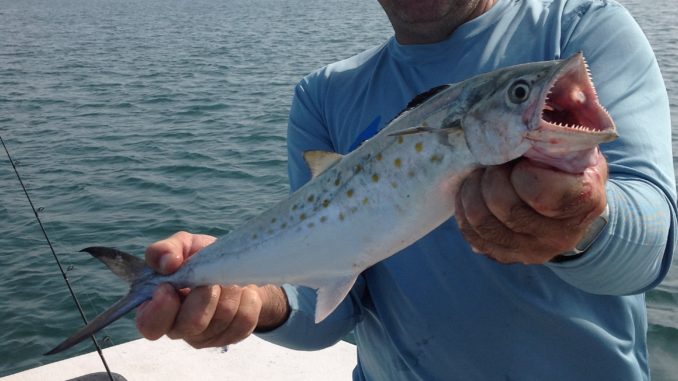
Cooler waters have brought fish closer to shore near Beaufort Inlet
The water has only cooled a degree or two, but Capt. Noah Lynk of Harkers Island said it’s been enough to gather Spanish mackerel and bluefish around Beaufort Inlet to devour mullet minnows and other baitfish being swept out on every falling tide.
“The larger Spanish are usually found over around Cape Lookout, but this year they have shown up off Fort Macon first,” said Lynk, of Noah’s Ark Fishing Charters. “I guess I shouldn’t be surprised though. Very little else since mid-spring has followed the usual patterns. Even the temperature didn’t get as hot as usual. The water really hasn’t cooled but a degree or so, but it was four to five degrees cooler than usual all summer, so it didn’t have to cool much to get the bait moving and the fish excited.”
Lynk (252-342-6911) said he’s been catching Spanish trolling Clark Spoons for Spanish and some 2- to 4-pound bluefish, but locating a school, stopping and casting on light tackle has been a blast.
“Some of these fish have been heavier than five pounds, so they can really zing a small reel,” Lynk said. “They are a whole lot more fun to catch without dealing with planers and trolling sinkers. You know you’ve done something when you land one on light tackle, I’m using 4000 size Star Reels on 6-12 and 8-16 rated Star Rods. It’s a lot different than using trolling outfits.”
Lynk’s favorite lure to cast to Spanish has been a 2-inch Salty Bay Baits Glass Minnow in clear/flake on a 1/8- or 1/4-ounce Darter jighead, which has a gold hook. The combination has caught Spanish to six pounds – and plenty of 2- to 4-pound fish.
Some bluefish have been mixed in with the Spanish, hitting the same lures, but Lynk said you can speed up your retrieve and mostly catch Spanish.
“This is early morning and late afternoon fishing,” Lynk said. “If you don’t like to get up early, then wait until 4:00 p.m. or so to head out. They usually bite really well from first light until about 10:00 a.m. or so – maybe a little later on a cool overcast day. They disappear during the middle of the day when the sun is overhead but show back up and feed again from the late afternoon to just before dark. The afternoon action isn’t quite as good as the morning, but you can catch limits most days.”

